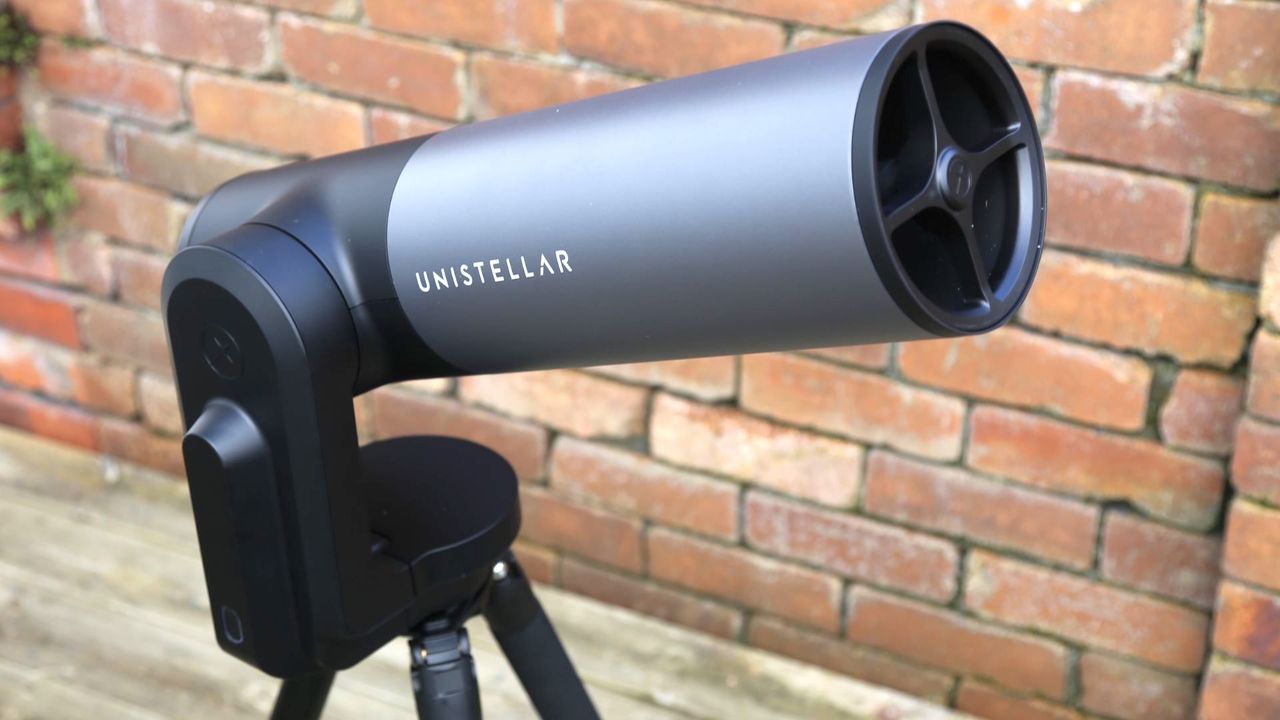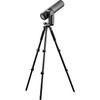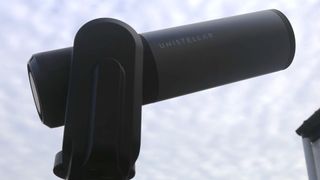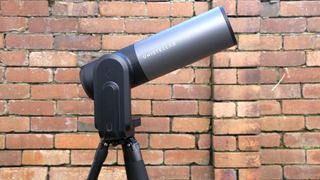ActiveOutdoorsOutdoor TechUnistellar eQuinox II review: Brilliant smartphone-controlled telescopeNo eyepiece, no complicated set-up, just great images sent straight to your smartphoneWhen you purchase through links on our site, we may earn an affiliate commission.Here’s how it works.(Image credit: Jamie Carter)T3 VerdictOne of the only telescopes without an eyepiece, this second-generation version is Unistellar’s most affordable smart telescope yet. It comes with more megapixels and a new planet mode, but at its core is excellent image processing that makes deep-sky objects look bright and colourful even under light-polluted night skies.Reasons to buy+Very easy to set-up+New ‘planet mode’+Excellent build quality+Slick smartphone app+Higher resolution images+Sees through light pollutionReasons to avoid-Needs occasional manual focusing-No ‘Moon mode’-Expensive relative to other telescopesWhy you can trust T3Our expert reviewers spend hours testing and comparing products and services so you can choose the best for you.Find out more about how we test.
ActiveOutdoorsOutdoor TechUnistellar eQuinox II review: Brilliant smartphone-controlled telescopeNo eyepiece, no complicated set-up, just great images sent straight to your smartphoneWhen you purchase through links on our site, we may earn an affiliate commission.Here’s how it works.(Image credit: Jamie Carter)T3 VerdictOne of the only telescopes without an eyepiece, this second-generation version is Unistellar’s most affordable smart telescope yet. It comes with more megapixels and a new planet mode, but at its core is excellent image processing that makes deep-sky objects look bright and colourful even under light-polluted night skies.Reasons to buy+Very easy to set-up+New ‘planet mode’+Excellent build quality+Slick smartphone app+Higher resolution images+Sees through light pollutionReasons to avoid-Needs occasional manual focusing-No ‘Moon mode’-Expensive relative to other telescopesWhy you can trust T3Our expert reviewers spend hours testing and comparing products and services so you can choose the best for you.Find out more about how we test.
No eyepiece, no complicated set-up, just great images sent straight to your smartphone
When you purchase through links on our site, we may earn an affiliate commission.Here’s how it works.
(Image credit: Jamie Carter)T3 VerdictOne of the only telescopes without an eyepiece, this second-generation version is Unistellar’s most affordable smart telescope yet. It comes with more megapixels and a new planet mode, but at its core is excellent image processing that makes deep-sky objects look bright and colourful even under light-polluted night skies.Reasons to buy+Very easy to set-up+New ‘planet mode’+Excellent build quality+Slick smartphone app+Higher resolution images+Sees through light pollutionReasons to avoid-Needs occasional manual focusing-No ‘Moon mode’-Expensive relative to other telescopes
(Image credit: Jamie Carter)

(Image credit: Jamie Carter)
T3 VerdictOne of the only telescopes without an eyepiece, this second-generation version is Unistellar’s most affordable smart telescope yet. It comes with more megapixels and a new planet mode, but at its core is excellent image processing that makes deep-sky objects look bright and colourful even under light-polluted night skies.Reasons to buy+Very easy to set-up+New ‘planet mode’+Excellent build quality+Slick smartphone app+Higher resolution images+Sees through light pollutionReasons to avoid-Needs occasional manual focusing-No ‘Moon mode’-Expensive relative to other telescopes
T3 VerdictOne of the only telescopes without an eyepiece, this second-generation version is Unistellar’s most affordable smart telescope yet. It comes with more megapixels and a new planet mode, but at its core is excellent image processing that makes deep-sky objects look bright and colourful even under light-polluted night skies.
T3 Verdict
One of the only telescopes without an eyepiece, this second-generation version is Unistellar’s most affordable smart telescope yet. It comes with more megapixels and a new planet mode, but at its core is excellent image processing that makes deep-sky objects look bright and colourful even under light-polluted night skies.
Reasons to buy+Very easy to set-up+New ‘planet mode’+Excellent build quality+Slick smartphone app+Higher resolution images+Sees through light pollutionReasons to avoid-Needs occasional manual focusing-No ‘Moon mode’-Expensive relative to other telescopes
Reasons to buy+Very easy to set-up+New ‘planet mode’+Excellent build quality+Slick smartphone app+Higher resolution images+Sees through light pollution
Very easy to set-up
New ‘planet mode’
Excellent build quality
Slick smartphone app
Higher resolution images
Sees through light pollution
Reasons to avoid-Needs occasional manual focusing-No ‘Moon mode’-Expensive relative to other telescopes
Needs occasional manual focusing
No ‘Moon mode’
Expensive relative to other telescopes
Why you can trust T3Our expert reviewers spend hours testing and comparing products and services so you can choose the best for you.Find out more about how we test.
Why you can trust T3Our expert reviewers spend hours testing and comparing products and services so you can choose the best for you.Find out more about how we test.
Unistellar eQuinox 2 deals
1 Amazon customer review☆☆☆☆☆
1 Amazon customer review☆☆☆☆☆
☆☆☆☆☆
$2,499View$2,499ViewNo price informationCheck Amazon
$2,499View
$2,499View


$2,499View
$2,499
$2,499
$2,499View
$2,499View


$2,499View
$2,499
$2,499
No price informationCheck Amazon
No price informationCheck Amazon

No price informationCheck Amazon
No price information
No price information
We check over 250 million products every day for the best prices
Unistellar eQuinox II review in a sentence: If you’re keen on controlling your smart telescope with your smartphone, the Unistellar eQuinox II will give you the most bang for your buck.
Let’s get straight to it – it’s one of thebest telescopesaround, particularly if you love the idea of sitting inside while a telescope sends real-time deep-sky images straight to your smartphone. A 4.5-inch reflector telescope (here’s an explainer of thedifferent telescope types) does away with an eyepiece in favour of an image sensor.
It may sound advanced, but it’s so easy to use – and performs so well under light-polluted urban skies – that it ranks as one of thebest telescopes for beginnersboth with deep sky objects and, now, planets. Throw in the chance to take observations for NASA scientists wanting to crowdsource observations of exoplanets, asteroids and comets, and this is one seriously impressive light bucket. Could the Unistellar eQuinox II change amateur astronomy forever? It sure could – and it’s the most affordable smart telescope yet.
(Image credit: Jamie Carter)

(Image credit: Jamie Carter)
Unistellar eQuinox II review: Specifications
Unistellar eQuinox II review: Price and availability
(Image credit: Jamie Carter)

(Image credit: Jamie Carter)
Unistellar eQuinox II review: Features and what’s new
New for this version are planet mode and a wider field of view. The former makes it possible to see the likes of Mars, Jupiter and Saturn thanks to super-short exposures while the latter means it’s possible to capture more of large galaxies and star clusters such as the Andromeda galaxy and the Pleiades open cluster – both iconic sights in the night sky. There’s also a new app, which now includes a citizen science section. It’s possible to observe targets such as exoplanets, asteroids and comets and help scientists make discoveries and learn more about objects. Once you’ve signed up it’s very easy to scroll through a list of potential observations, have your telescope observe for, say, 20 minutes – some at a very specific time – then upload the raw data to NASA or SETI.
(Image credit: Jamie Carter)

(Image credit: Jamie Carter)
Unistellar eQuinox II review: Set-up and use
Thanks to something called Autonomous Field Detection technology, the Unistellar eQuinox II is stupidly easy to use. Set up outside on its sturdy tripod, the Unistellar eQuinox II looks for stars – any stars, even faint ones – and matches them to its vast database of over 37 million stars. It almost never fails, and within about a minute of switching it on it’s ready to make observations. That is not how most telescopes work, instead requiring lengthy alignments with bright stars. That said, it’s worth first pointing the Unistellar eQuinox 2 at a bright star to get a sharp focus, something that must be done manually.
With a smartphone or tablet attached to the Unistellar eQuinox II’s own WiFi network and the Unistellar app downloaded it’s possible to choose from 5,000 nebulae, galaxies and planets. However, the app makes it easy to choose, putting bright and well-placed objects at the top of the list. Tap on one and the Unistellar eQuinox II slews to it and begins taking a series of short exposures. All you do then is sit back and wait for the image to improve. For example, a stack of images from about five minutes of observations will give you a good impression of a galaxy, but leave it for an hour and you’ll see incredible detail in its dust lanes and spiral arms. Ditto for faint nebulae, some of which don’t reveal themselves for at least 30 minutes.
At any point, it’s possible to download the image to a smartphone or save a lossless 6.2 megapixel version to the telescope’s 64GB hard disk. Always detailed enough and often incredibly colourful, they’re streets ahead of what you’ll see through an optical telescope – particularly from a city – which is why smart telescopes like the Unistellar eQuinox II look destined to change amateur astronomy forever.
(Image credit: Jamie Carter)

(Image credit: Jamie Carter)
Unistellar eQuinox II review: Verdict
If you’re set on a smart telescope to control with your smartphone, then it’s the Unistellar eQuinox II that will give you the most bang for your buck. Very easy to set up and use and with enjoyable images even when used in light-polluted cities, the Unistellar eQuinox II is a genuinely innovative telescope that could change how we observe the night sky forever.
Unistellar eQuinox II review: Alternatives to consider
If you’re set on a smart telescope, then there are two others available. A smaller yeti similarly priced alternative is theVaonis Vespera, which is hugely enjoyable to use and more portable, though offers less detailed images. Meanwhile, the step-upUnistellar eVscope 2offers more detailed images and a Nikon-made electronic OLED eyepiece, though physically, it’s almost identical to the eQuinox II.
Unistellar eQuinox 2: Price Comparison
1 Amazon customer review☆☆☆☆☆
1 Amazon customer review☆☆☆☆☆
☆☆☆☆☆
$2,499View$2,499ViewNo price informationCheck Amazon
$2,499View
$2,499View


$2,499View
$2,499
$2,499
$2,499View
$2,499View


$2,499View
$2,499
$2,499
No price informationCheck Amazon
No price informationCheck Amazon

No price informationCheck Amazon
No price information
No price information
We check over 250 million products every day for the best prices
Sign up to the T3 newsletter for smarter living straight to your inbox
Get all the latest news, reviews, deals and buying guides on gorgeous tech, home and active products from the T3 experts

OnePlus 13 gets its first major free update, including a neat new featureOn-device AI incoming, plus camera improvements
On-device AI incoming, plus camera improvements

Anker upgrades Everfrost Cooler with improved battery life and new size optionsIt now provides up to 104 hours (over four days) of cooling
It now provides up to 104 hours (over four days) of cooling

Nintendo’s crazy smart alarm clock will soon be on general saleThe playful Alarmo clock is ending online exclusivity to land in a store near you
The playful Alarmo clock is ending online exclusivity to land in a store near you

